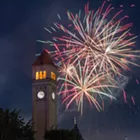But his warning came too late. The men of the Corps of Discovery, whose normal daily diet consisted almost exclusively of red meat, had already eaten heartily at the Nez Perce buffet of berries, roots and salmon. Clark saw Lewis become so weak that he was "Scercely able to ride on a jentle horse" and "Several men so unwell that they were Compelled to lie on the Side of the road for Some time." Clark rummaged through the expedition medicine chest, but no pills, salts or tonic brought from Philadelphia could relieve the men's distress. Private Joseph Whitehouse lamented that, "Several of the men Sick with the Relax, caused by a suddin change of diet and water as well as the climate." Even a week later Clark lamented that, "Our men nearly all Complaining of ther bowels, a heaviness at the Stomack & amp; Lax."
In spite of the illness in camp, there was work to be done. First on Clark's to-do list was convening a cartography conference with the Nez Perce. There being no interpreter when he interviewed Twisted Hair, "we were Compelled to converse alltogether by Signs." Drawing on a white elk skin with charcoal, Twisted Hair traced the westward flow of the Clearwater River, conveying as best he could the "Situation of Indians" ahead and noting two major tributaries. He recorded the distances as "2 Sleeps" and "5 Sleeps" beyond.
Next there was the matter of constructing canoes. While on the Lolo Trail, Lewis saw trees which he estimated to be "large enough to form eligant perogues of at least 45 feet in length," meaning dugout canoes. Clark had no intention of returning to the mountains for suitable trees, so, taking Twisted Hair and his two sons with him, he scouted along the Clearwater River in a hunt for "trees Calculated to build Canoes." He found his so-called Canoe Camp opposite the mouth of the North Fork of the Clearwater, not far from today's Orofino, Idaho. The site held several large, straight ponderosa pine trees, each with a minimum of knots. Best of all, they could be felled in close proximity to the river and, upon completion as dugouts, could easily be shoved into the water. Beginning Sept. 27, "all the men able to work comenced building 5 Canoes, Several taken Sick at work."
Shaping dugout canoes -- essentially hollowed-out logs -- with an adz and ax is labor-intensive, a fact Clark had learned earlier in the spring. At both Fort Mandan and the Great Falls of the Missouri, members of the expedition built a total of eight dugouts. From this experience, Clark knew that "our axes are Small & amp; badly Calculated to build Canoes of the large Pine." Happily, Nez Perce leaders offered good advice to the Corps. Instead of chopping deep into the log with axes, Twisted Hair urged the explorers to flatten the topside of the tree and then blanket it with hot coals. When the wood charred sufficiently, it could be easily chipped out. The recommended process took more time but less work -- an important consideration when many of the explorers felt ill. Clark wisely followed the instructions of his Nez Perce mentor and work on the canoes began in earnest.
Next week: Still sick, the Corps makes final preparations for their river journey to the Pacific.
Robert Carriker has directed eight National Endowment for the Humanities seminars on the Lewis and Clark expedition and is author of Ocean in View! O! the Joy. When he's not out retracing the steps of the Corps of Discovery, he teaches history at Gonzaga University.















